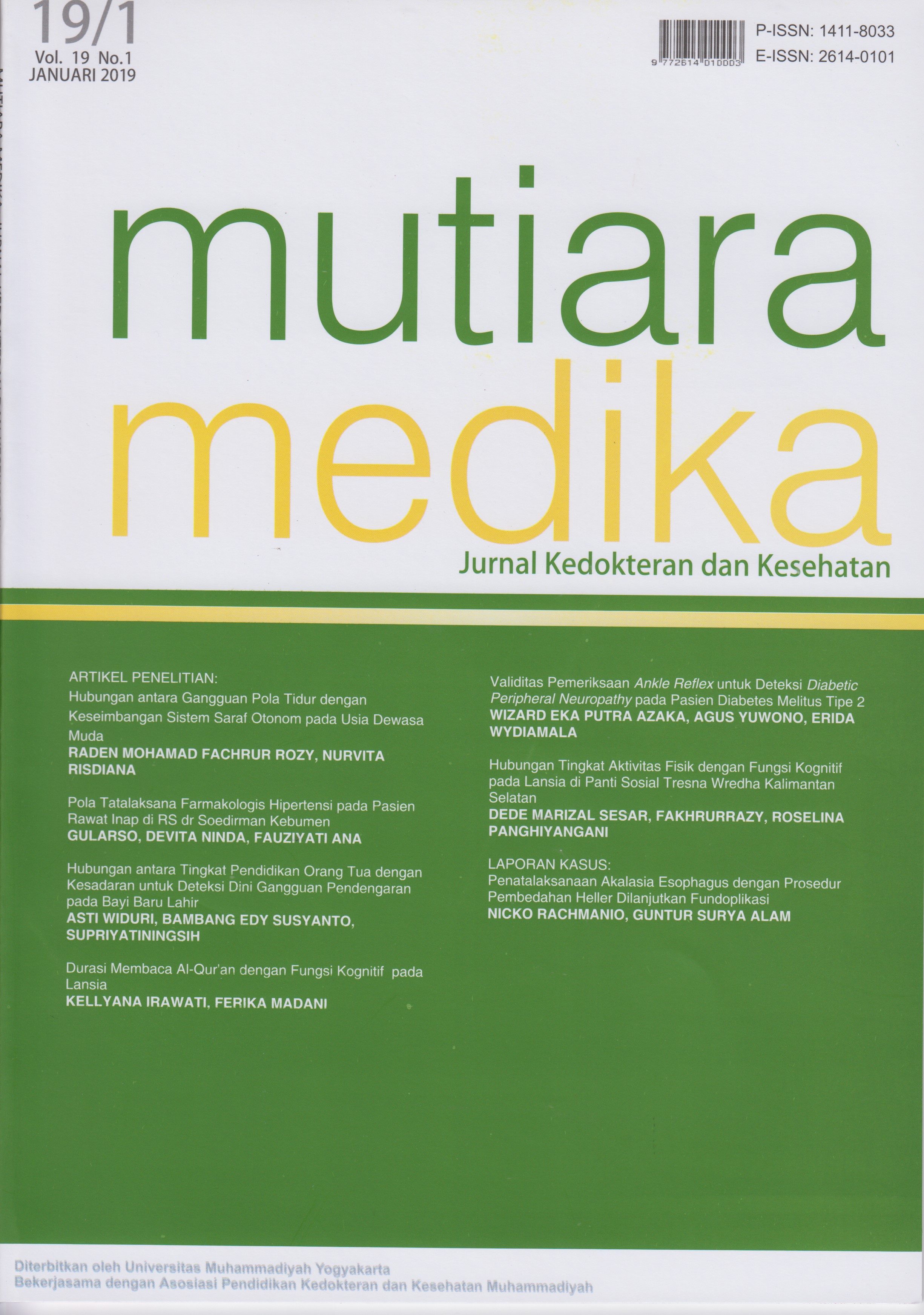Validitas Pemeriksaan Ankle Reflex untuk Deteksi Diabetic Peripheral Neuropathy pada Pasien Diabetes Melitus Tipe 2
DOI:
https://doi.org/10.18196/mm.190124Keywords:
Validitas, Ankle Reflex, Diabetic Peripheral Neuropathy, Diabetes Melitus Tipe 2Abstract
Diabetic Peripheral Neuropathy (DPN) adalah bentuk komplikasi yang paling banyak pada pasien diabetes. Ankle Reflex (AR) merupakan pemeriksaan fisik sederhana yang dapat digunakan sebagai prosedur deteksi untuk mencegah morbiditas dan mortalitas yang disebabkan oleh DPN dengan mengevaluasi fungsi saraf sensoris dan motoris. Tujuan penelitian ini adalah untuk mengetahui validitas AR sebagai prosedur deteksi DPN pada pasien diabetes melitus (DM) tipe 2. Penelitian dilakukan di RSUD Dr. H. Moch. Ansari Saleh Banjarmasin. Jenis penelitian ini adalah uji diagnostik dengan pendekatan cross-sectional. Penelitian melibatkan 69 pasien DM tipe 2 di Poliklinik Penyakit Dalam sebagai peserta. Pasien dievaluasi menggunakan skor Diabetic Neuropathy Examination (DNE), Diabetic Neuropathy Symptom (DNS) dan pemeriksaan AR. Data dianalisis menggunakan tabel uji diagnostik 2x2 dan kurva receiving operating characterictic (ROC). Hasil menunjukkan bahwa AR memiliki nilai sensitivitas 100%, spesifisitas 72,73%, akurasi 82,61%, nilai duga positif 67,57%, nilai duga negatif 100%, dan 0.88 area under curve (AUC). Simpulan penelitian ini adalah AR memiliki nilai validitas yang baik dan dapat digunakan sebagai prosedur deteksi DPN yang cepat dan mudah untuk pasien DM tipe 2.
References
Kementerian Kesehatan RI. Infodatin Pusat Data dan Informasi Kementerian Kesehatan RI. Jakarta: Kemeterian Kesehatan RI. 2014.
Ametov AS, Barinov A, Dyck PJ, Hermann R, Kozlova N, Litchy WJ, et al. The Sensory Symptoms of Diabetic Polyneuropathy are Improved with Alpha Lipoic Acid: The Sydney rial. Diabetes care, 2003; 26 (3): 770-776.
Setiati S, Alwi I, Sudoyo AW. Buku Ajar Ilmu Penyakit Dalam Jilid II Edisi VI. Jakarta: Interna Publishing. 2014.
Sadeli HA. Nyeri Neuropati Diabetika. Dalam: Meilala L, Suryamiharja, Wirawan, Sadeli HA, Amir D. Editor. Nyeri Neuropatik. Yogyakarta: Medigama Press. 2008. P.77-90.
Alexandra H, Cristopher HG. Diagnosis and Treatment of Pain in Small Fiber Neuropathy. Curr Pain Headache Rep, 2011; 15 (3): 193-200.
Meijer JW, Bosma E, Lefrant JD. Clinical Diagnosis of Diabetic Polyneuropathy with the Diabetic Neuropathy Symptom and Diabetic Neuropathy Examination Scores. Diabetes Care, 2003; 26 (3): 697-701.
Sopiyudin DM. Penelitian Diagnostik Dasar-dasar Teoretis dan Aplikasi dengan Program SPSS dan Stata. Seri Evidence Based Medicine 5. Jakarta: Penerbit Salemba Medika. 2009.
Jayaprakash P, Anil B, Shobhit B, Pinaki D, Anantharaman R, Shanmugasundar G, et al. Validation of Beside Methods in Evaluation of Diabetic Peripheral Neuropathy. Indian J Med Res, 2011; 133 (6): 645-649.
Shehab DK, Al-Jarallah KF, Abraham M, Mojiminiyi OA, Al-Mohamedy H, Abdella NA. Back to Basics: Ankle Reflex in the Evaluation of Peripheral Neuropathy in Type 2 Diabetes Mellitus. QJM, 2012; 105 (4): 315-320.
Bowditch MG, Sanderson P, Livesey JP. The Significance of an Absent Ankle Reflex. J Bone Joint Surg, 1996; 78 (2): 276-279.
Bharati T, Saima A, Ashish J, Vikas K. The Diagnostic Sensitivity, Specificity and Reproducibility of the Clinical Physical Examination Signs in Patients of Diabetes Mellitus for Making Diagnosis of Peripheral Neuropathy. J Endocrinol Metab, 2011; 1 (1): 21-26.
Perkins BA, Vera B. Diabetic Neuropathy: A Review Emphasizing Diagnostic Methods. Clin Neurophysiol, 2003; 114 (7): 1167-1175.
Downloads
Published
Issue
Section
License
Copyright
Authors retain copyright and grant Mutiara Medika: Jurnal Kedokteran dan Kesehatan (MMJKK) the right of first publication with the work simultaneously licensed under an Attribution 4.0 International (CC BY 4.0) that allows others to remix, adapt and build upon the work with an acknowledgment of the work's authorship and of the initial publication in Mutiara Medika: Jurnal Kedokteran dan Kesehatan (MMJKK).
Authors are permitted to copy and redistribute the journal's published version of the work (e.g., post it to an institutional repository or publish it in a book), with an acknowledgment of its initial publication in Mutiara Medika: Jurnal Kedokteran dan Kesehatan (MMJKK).
License
Articles published in the Mutiara Medika: Jurnal Kedokteran dan Kesehatan (MMJKK) are licensed under an Attribution 4.0 International (CC BY 4.0) license. You are free to:
- Share — copy and redistribute the material in any medium or format.
- Adapt — remix, transform, and build upon the material for any purpose, even commercially.
This license is acceptable for Free Cultural Works. The licensor cannot revoke these freedoms as long as you follow the license terms. Under the following terms:
Attribution — You must give appropriate credit, provide a link to the license, and indicate if changes were made. You may do so in any reasonable manner, but not in any way that suggests the licensor endorses you or your use.
- No additional restrictions — You may not apply legal terms or technological measures that legally restrict others from doing anything the license permits.






